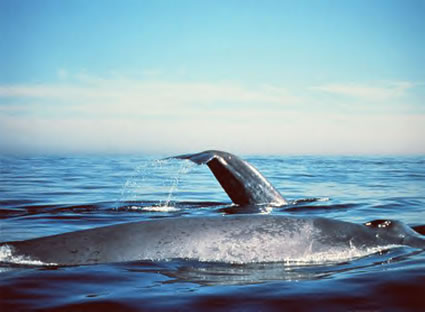|

Description |
| |
| The blue whale is the largest animal to have lived. It can grow to over 100 feet in length (3 school buses) and weigh well over 120 tons ( 240,000 pounds). One female was reported as weighing 174 tons! Blue whales have bluish-gray or gray bodies with light white spots throughout. Their underbellies are white or light gray. Flippers can be eight feet long, and the tail (flukes) may reach a length of over 25 feet. The blue whale is so large that it heart needs to be the size of a car to pump blood throughout its massive body. The blue whale has two blowholes on the top of its body. Blow holes function like human nostrils but can shoot water 30 feet into the air! The whale’s large layer of blubber helps it stay warm when swimming through very cold water. |
| |
Diet |
| |
| Despite its size, the blue whale does not eat large animals. In fact, its diet is formed by microscopic shrimp-like organisms called krill. Krill are one of the most important organisms in the ocean ecosystems, as many large whales depend on prodigious amounts to survive. Blue whales gulp huge amounts of ocean water filled with millions of krill and plankton. The water is then filtered through baleen plates in the whale’s jaw. As the water escapes through the baleen plates, the krill and plankton are retained. Baleen plates work much like a water filter you may have on your kitchen sink. Such plates allow the blue whale to consume about 2,000-9,000 pounds of krill per day, or 40,000,000 individual krill. You would have to eat 8,000-36,000 cheeseburgers per day to eat the same amount. The blue whale has about 320 baleen plates on each side of its jaw. They are each more than three feet in length. In addition, the whale’s tongue may weigh 4 tons and can hold 50 people. |
| |
Habitat and Range |
| |
| Blue whales inhabit virtually all parts of the Earth’s oceans except for extreme polar seas. They generally stay near the surface and give birth in warmer waters. Blue whales are fast swimmers despite their size, and can reach speeds of 30 miles per hour in short bursts. |
| |
Breeding |
| |
| Female blue whales give birth to a single calf that comes out tail-first. The newborn calf instinctively rises to the surface with its mother's help to take its first breath of oxygen. The calf weighs 6-8 tons, or about 1,800 times the size of a human baby. The young blue whale grows very fast and will drink about 200 pounds of its mother's milk per day. Calves stay with their mothers for about a year. |
| |
Communication |
| |
| The blue whales is the world's loudest animal. Their whistles are louder than a jet engine and can be heard for miles underwater. Whistles are used to communicate with other whales and to locate large bodies of krill. |
| |
Status |
| |
| Blue whale populations have experienced alarming declines. Today, there are wide estimates concerning the number of blue whales alive. Estimates range from as few as 1,300 to as many as 14,000. The giant but gentle blue whale was hunted mercilessly by whale hunters and nations that sponsored whale hunting. Their meat, oil, and body parts were harvested by hunters on ships equipped with long daggers that could be shot out like arrows called harpoons. It is now illegal to hunt Blue whales and populations may be rising again. |
| |
|